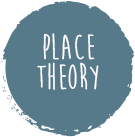

Place
by Sally Mackey
This page says a little more about ‘place’ – why it’s important, what might be meant by ‘place’, where some of the theory-around-place comes from and offers more information about the award that led to this website.
Why is place important?
For many years, I have been interested in the importance of ‘place’ in people’s lives. We live at a time of global instability, movement and deterritorialism on the one hand and, on the other, sometimes unwelcome embeddedness because of poverty, detainment or age, for example. Our relationship with ‘place’ can be uneasy as a result.
Applied theatre, community drama, drama and theatre education or socially engaged performance practices have an important and useful role to play in involving people with place. This might be to ease difficult locations, see everyday dull places in a new light, create ‘special’ places in transient lives, challenge unhappy perceptions of previously known sites or celebrate shared places with a view to engaging further understandings of that place. Performance practices can provide opportunities for encouraging individual (and shared) pleasure in physical locations and associated operations.
Place
I differentiate place from site and space.
Site can be interpreted as a geographical location without particular personal attachment or inhabitation.
Space can refer to
- the physical dimensions and dynamics of places
- amorphous, untenanted, non-tangible areas that are generalised as ‘space’ (e.g. the space on a website; spaces of desert…)
- external, global networks that interact with place (the spaces of the internet; the spaces of global finance…)
- a descriptive term for an area of thought and action (e.g. safe spaces; creative spaces)
I describe place differently:
[P]lace is space (or site) animated through operations and actions and made personal. Place is geographically located … inhabited briefly or over a longer period, constructed through a range of operations, actions and behaviours and, through these, a psychological relationship is developed with place. This latter may not necessarily be a positive relationship although frequently place is associated with ‘attachment’...(Mackey, 2015)
There has been an increased consideration of virtual place, whether through connected global communities of interest, quasi-inhabited places through avatar manipulation or a range of GPS-located games and activities, for example. Sometimes the virtual replicates or is attached to the geophysical and ‘real’ place. Not yet a part of the arguments for ‘performing places’, no doubt it will become so.
For further thinking about concepts of place, and related to the Half Moon project within the ‘Challenging Place’ project, see www.challengingplacehalfmoon.org
Linked to the previous section, a further differential for me between site and place is in their performance. Site-based performance (e.g. site-specific work) is often undertaken by performers (professional, students, ‘outsiders’…) working on and with a site. Performing place, I would argue, is a ‘performance’ by participants who live in that area and who are not necessarily performers (see the Oldham project on this website). If place is somewhere with which one has a personal relationship, and where one dwells – albeit possibly temporarily – then it follows that a performance of place is primarily with participants. It is a participatory practice in the applied field.
For a detailed ‘hypothesis’ on performing place that happened at a site called Caer Llan see: Performing Place 1.pdf and Performing Place 2.pdf
The ‘Challenging Place’ projects tried out ideas first identified at Caer Llan. For additional ‘findings’ from the Half Moon project (as well as those presented on this website), see: www.challengingplacehalfmoon.org/inconclusions
Theories around place
This offers the briefest of summaries on relevant place theorists.
The ‘theorists of the everyday’ – all French, male and white – of the 1960s and 1970s offered a foundation for our understanding of place as socially constructed and animated through repeated operations and actions (Bourdieu, 1977; Lefebvre, 1991; de Certeau, 1984). Although there is confusion over the terms space and place in some of these texts, the basic premise of creating place/space through the interaction of human behaviours and physical locations is stated.
Geographer Doreen Massey in the UK developed a global understanding of place (e.g. 1997; 2005) with her developing exploration of place as globally connected and diverse, and comprising a range of people and their ‘stories’ or narratives collecting in one place at one time – and then potentially moving on. Hers is a place that includes mobility, people move around, perhaps in tune with other philosophical thinking about nomadism and migrancy (e.g. Deleuze and Guattari, 1987; Cresswell, 2006). Other UK academics such as Tim Ingold have emphasised the role of dwelling in place-making (2000), whilst also recognising mobility and how we take account of nature and culture in that dwelling.
That place ‘matters’ in everyday lives today has been demonstrated through a number of social research projects in the 2000s. Groups of people in the UK have been surveyed with results ‘proving’ that attachment to place is an important facet of community living. (See, for example, Livingston et al, 2011.)
There is much more…
Further info: the award that led to this website
Together with Margaret Ames and Mike Pearson as co-investigators, I worked on some of these ideas in the AHRC-funded research grant: ‘Challenging Concepts of "Liquid" Place through Performing Practices in Community Contexts’ (2011-2014). These were the original aims and objectives attached to the grant.
The aim of the project was to investigate the research questions:
- What can practical intervention tell us about how abstract concepts such as place, community, dislocation and belonging, as theorised by contemporary academics, map onto the 'real life' experiences of vulnerable social groups?
- Can one or more models of performance practices help ease feelings of ‘dislocation’ among community participants, where such feelings exist?
- How might such models be evaluated, disseminated and made fully accessible to community theatre organisations?
The objectives are to:
- achieve three performing-place practical outcomes;
- record, evaluate and analyse the impact of these interventions in the three community settings;
- modify the models of performance practice in the light of outcomes of the three projects;
- present these as a workable facilitation 'pack' for use by a large number of community arts organisations;
- re-examine theories of the performance of place in applied contexts addressing extant and emergent interdisciplinary approaches to dislocation and mobility;
- disseminate the results of the work through three peer-reviewed journal articles, a symposium (for 75 or more community theatre organisations) and webpages containing the facilitation material; submit a book proposal on place and applied theatre practices.
As is the way of research projects, some of these changed within the three-year period.
References
| Bourdieu, P. | (1977) Outline of a Theory of Practice, (trans. R. Nice), Cambridge University Press. |
| Cresswell, T. | (2006) On the Move: Mobility in the Modern Western World, New York and London: Routledge. |
| De Certeau, M. | (1984) The Practice of Everyday Life, (trans. S. Rendall) London: University of California Press. |
| Deleuze, G and Guattari, F. | (1987) A Thousand Plateaus: Capitalism and Schizophrenia, (trans. B. Massumi, Minneapolis: University of Minnesota Press. |
| Ingold, T. | (2000) The Perception of the Environment: Essays on Livelihood, Dwelling and Skill, London and New York: Routledge. |
| Lefebvre, H. | (1991 [1974]) The Production of Space, (trans. D. Nicholson- Smith) Oxford: Blackwell. |
| Livingston, M., Bailey, N. and Kearns, A. | (2011) People’s Attachment to Place: the Influence of Neighbourhood Deprivation, York: Joseph Rowntree Foundation. |
| Mackey, S. | (2015) ‘Applied Theatre and Place’ (working title) in J. Hughes and Nicholson, H. (eds) Critical Perspectives in Applied Theatre, Cambridge University Press. |
| Massey, D. | (2005) For Space, London, Sage. |
| Massey, D. | (1997) ‘A Global Sense of Place’ in Barnes, T. and Gregory, D. (eds.) Reading Human Geography, London: Arnold, pp. 315-323 |

